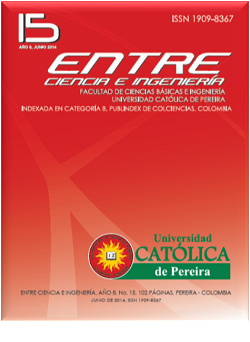Impact of the speed and mobility model in a data communication for a vehicular network
Keywords:
mobility model, Simulation, V2V, VANET, speedAbstract
In the last few years, wireless networks haveevolved in their development in order to support new servicesand optimize the performance of traditional services for finalusers. Under this context, one of the new topics with majorscientific interest is the communication in vehicular ad hocnetworks (VANET), which refers to vehicles interconnectionamong them and between fixed infrastructures. VANET presentspecial features in aspects like throughput, reliability, nodes’speed and bandwidth in comparison to other wireless networks.As a result, mobility models have emerged to quantify node’smovement and studies are necessary to analyze how mobilitymodels can affect a communication in a VANET.
References
S. Senouci, H. Moustafa y M. Jerbi, Vehicular Networks: Techniques, Standards and Applications, 1a ed. Boston, Massachusetts, USA: Auerbach Publications, 2009. Cap. 1.
I. Leontiadis y C. Mascolo, “GeOpps: Geographical Opportunistic Routing for Vehicular Networks,” en IEEE Internat. Sympos. on World of Wireless, Mobile and Multimedia Networks, Helsinki: Finlandia, ACM 2007: pp. 1-6.
A. Mahajan et al., “Evaluation of Mobility Models for Vehicular Ad-hoc Network Simulations,” Reporte Técnico N.051220, Universidad del Estado de Florida, USA, 2005.
A. Cabrera y E. Casilari, “Acceso a Internet desde los Vehículos,” Departamento de Tecnología Electrónica, Universidad de Málaga, España, 2008.
R. Baumann, “Vehicular Ad hoc Networks (VANET): Engineering and simulation of mobile ad hoc routing protocols for VANET on highways and in cities” Tesis de Maestría, Instituto Suizo Federal de Tecnología, Zurich, Suiza, 2004
Y. Chen et al., “Network Mobility Protocol for Vehicular Ad Hoc Networks,” en Wirel. Commun. and Networking Conference, Budapest: Hungría: ACM: 2009, pp. 1-6.
A. Pachón, C. Nieto y M. Velasco, “Modelos de comportamiento de las redes vehiculares en sus escenarios más representativos, utilizando simulación en la herramienta NCTUns,” Sistemas y Telemática: Revista de la Facultad de Ingeniería, Universidad ICESI, vol. 8, no 15, Ene. 2010, pp. 13-25.
V. Sardeshmukh, “Vehicular Ad Hoc Networks,” en Class Conference in School of Information Technology, Kharagpur: India, 2010.
M. Gerla, L. Kleinrock, Vehicular networks and the future of the mobile internet, Comput. Netw. (2011), doi:10.1016/j. comnet.2010.10.015.
R. Baldessari et al., “Flexible Connectivity Management in Vehicular Communication Networks,” en Proc. of International Workshop on Intelligent Transportation, Hamburgo, Alemania, Marzo 2006.
T. Strang y M. Rockl, Vehicle Networks-V2X communication protocols, Deutsches Zentrum fur Luft-und Raumfahrt, Colonia, Alemania, 2008.
H. Moustafa y Y. Zhang, Vehicular Networks: Techniques, Standards and Applications, 2a ed. Boston, Massachusetts: USA, Auerbach Publications, 2011.
International Telecommunication Union, ITU-T, Recommendation ITU-T Y.2281: Framework of networked vehicle services and applications using NGN, Enero 2011.
Car 2 Car Communication Consortium, Organisation. [Online]. Disponible: http://www.car-to-car.org/index.php?id=22 [Consultado: 20 Sep 2012].
A. Mahajan et al., “Urban Mobility Models for VANETs,” en Proc. of 2nd Workshop on Next Generation Wireless Networks, Bangalore, India, Diciembre 2006.
L. Khan, N. Ayub y A. Saeed, “Anycast Based Routing in Vehicular Adhoc Networks (VANETS) using Vanetmobisim,” World Applied Sciences Journal 7 (11), ISSN 1818-4952, IDOSI Publications, 2009, pp. 1341-1352.
J. Harri, et al., “Vehicular mobility simulation with vanet-mobisim,” Transactions of The Society for Modeling and Simulation, Septiembre 2009.
O. Orozco y G. Llano, “Aplicaciones para redes VANET enfocadas en la Sostenibilidad Ambiental, una Revisión Sistemática,” Revista Ciencia e Ingeniería Neogranadina, Universidad Militar Nueva Granada, vol. 24, no.2, Julio-Diciembre 2014, pp. 1-24.
O. Orozco y G. Llano, “OSA: A VANET Application Focused in Energy Efficiency,” 7th IEEE Colombian Conference on Communications and Computing (COLCOM), Bogotá: Colombia, Universidad de los Andes. Junio de 2014 (Proceedings).
M. Behrisch, L. Bieker, J. Erdmann y D. Krajzewicz. SUMO - Simulation of Urban MObility: An Overview In: SIMUL 2011, The Third International Conference on Advances in System Simulation, 2011.
Rapid Generation of Realistic Simulation for VANET, ChienMing Chou.[Online].Disponible:http://lens.csie.ncku.edu.tw/ Joomla_version/index.php/research-projects/past/18-rapid-vanet. [Consultado: 4 Mar 2014].
OMNeT++ Network Simulation Framework. [Online]. Disponible: http://www.omnetpp.org/. [Consultado: 12 Nov 2014].
Veins – Vehicles in Network Simulation, C. Sommer. [Online]. Disponible: http://veins.car2x.org/. [Consultado: 12 Nov 2014].
Miguel Hernán Muñoz Salamanca, Respuesta a Derecho de Petición, Secretaría de Tránsito Municipal, Popayán, Cauca, Abril de 2013.
A. Caicedo y J. Martínez, “Evaluación del Desempeño de Redes 802.11p/WAVE en la Transmisión de Datos, Voz y Video IP,” Tesis de Pregrado, Facultad de Ingeniería Electrónica y Telecomunicaciones, Universidad del Cauca, Popayán, Colombia, Diciembre 2011.








 Revista Entre Ciencia e Ingeniería
Revista Entre Ciencia e Ingeniería .png) entrecei@ucp.edu.co
entrecei@ucp.edu.co.png) ISSN (Impreso) 1909-8367 - ISSN (En Línea) 2539-4169
ISSN (Impreso) 1909-8367 - ISSN (En Línea) 2539-4169 Attribution-NonCommercial 4.0 International (CC By-NC 4.0)
Attribution-NonCommercial 4.0 International (CC By-NC 4.0)
.png) Carrera 21 No. 49-95 Av. de las Américas, Pereira, Risaralda, Colombia
Carrera 21 No. 49-95 Av. de las Américas, Pereira, Risaralda, Colombia